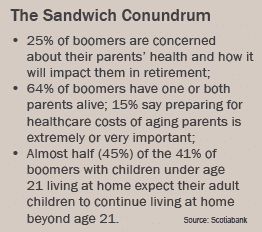
Are you caring for both children and parents at the same time? If so, you’re part of the “sandwich generation.” Adults in this group have at least one senior parent and are either raising a minor child or supporting a grown child1.
As the first wave of baby boomers moves into retirement, the ranks of the sandwich generation are swelling. A new retirement study from Scotiabank2 shows that baby boomers are concerned about assisting their aged parents and their adult children—and how that responsibility will affect their retirement cash flow.
The Financial Pinch
 The sandwich generation is pulled in many different directions. Balancing the needs of children and parents can put demands on your time and your emotions. It can also exact a significant financial burden. On one hand, you balance rising post-secondary education costs for the younger generation; on the other hand, you have rising medical costs for the older generation. The sandwich generation must also try to save for their own retirement, pay off their mortgages, etc. How do you deal with the financial toll?
The sandwich generation is pulled in many different directions. Balancing the needs of children and parents can put demands on your time and your emotions. It can also exact a significant financial burden. On one hand, you balance rising post-secondary education costs for the younger generation; on the other hand, you have rising medical costs for the older generation. The sandwich generation must also try to save for their own retirement, pay off their mortgages, etc. How do you deal with the financial toll?
Here are some steps to help take control:
Start the Conversation: Money is a sensitive topic for many families, but beginning open discussions with your parents about their finances can be beneficial in the long term. After all, it’s often easier to talk about money before the need arises. In addition, you and your parents might find that it is less difficult to discuss financial matters with your Cardinal Point advisor, who can offer a neutral setting and objective advice.
It’s important to review the following items: your parents’ retirement income, monthly expenses, insurance policies, health care coverage and estate plan. A thorough review can give you a better idea of the assistance (if any) that your parents will need from you, and then you and your Cardinal Point advisor can map out a plan.
A Leg Up for the Future: Those who belong to the sandwich generation are also trying to prepare for rising tuition costs. Our experts can help you select the right education savings plan to meet those costs. It’s also important to introduce strategies that empower your children to have a stake in their financial future. Encourage your kids to pitch in to their own education savings by offering to match what they put away for their education. In addition, make sure they’re prepared to have some savings to cover any unexpected expenses.
Don’t Forget About You: When fulfilling the needs of multiple generations, it can be easy to put your own requirements last. However, doing so could compromise your own financial well-being and your ability to care for those who depend on you. It’s important to look after yourself by exercising, getting enough rest and taking time to recharge. In the face of all your goals and obligations, it’s also essential to partner with your financial team to ensure you stay on course in helping your kids, your parents, and yourself.
1 “The Sandwich Generation: Rising Financial Burdens for Middle-Aged Americans.” PewResearch. January 2013.
2 “The Retirement Landscape — A Focus on the Baby Boomer.” Scotiabank. June 2014.